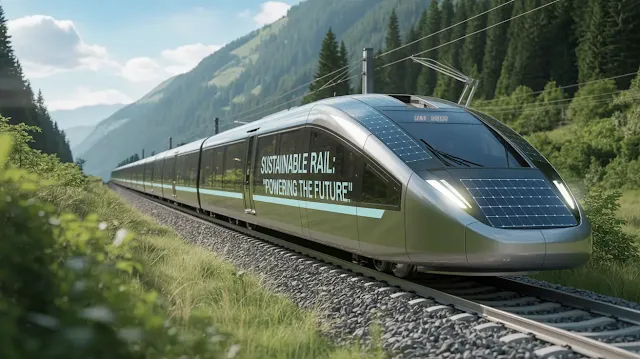Self-Charging Electric Trains: Can Railways Run Entirely on Renewable Energy?
The Next Frontier in Sustainable Rail Transport
As the world races toward carbon neutrality, the transportation sector is undergoing a green transformation. One innovation leading this charge is the self-charging electric train, a concept that combines renewable energy sources like solar power and kinetic energy to enable energy-autonomous rail systems.
This article explores how these trains function, the technologies behind them, and the countries already investing in this transformative rail solution.
How Self-Charging Trains Work: Beyond Conventional Electrification
Harnessing Solar Energy with Onboard Panels
Modern self-charging trains feature lightweight, flexible solar panels mounted on rooftops. These panels capture sunlight during daytime journeys and convert it into electricity. The energy is stored in advanced onboard batteries, enabling the train to operate independently from external power sources, especially useful in remote or off-grid areas.
Benefits:
Continuous energy production during daylightReduction in reliance on fossil fuel-powered grids
Eco-friendly and cost-saving over time
Kinetic Energy Regeneration: Power from Movement
Alongside solar integration, regenerative braking systems are a key component of self-charging electric trains. These systems recover energy when the train slows down or descends, converting kinetic energy into usable electricity.
Advantages include:
Energy recovery during braking cyclesLess waste of mechanical energy
Enhanced overall energy efficiency
The Rise of Hybrid Energy Systems in Rail
Merging Solar, Kinetic, and AI for Optimal Performance
The latest generation of self-charging trains doesn't rely on a single power source. Instead, it combines solar, regenerative braking, and smart energy management systems, often powered by AI, to deliver seamless, uninterrupted performance. These hybrid systems adapt in real time to optimize energy usage based on weather conditions, track gradients, and braking patterns.
Integration with Smart Infrastructure
In smart cities, trains are also connecting with intelligent energy grids. Through bidirectional charging at stations, they can:
Store surplus power generated en routeShare energy with station facilities
Draw from solar-powered grids only when necessary
This interconnected system reduces the strain on urban energy infrastructure while promoting circular energy consumption.
Real-World Adoption: Countries Leading the Shift
Australia’s Solar Train Prototype
Australia introduced one of the world’s first fully solar-powered trains in Byron Bay. Equipped with rooftop solar panels and onboard batteries, this model runs emission-free across a scenic route, proving the feasibility of self-powered rail systems.
Germany and Japan Push the Limits
Germany has launched hydrogen-electric hybrid trains capable of operating on non-electrified tracks, with regenerative braking systems enhancing their efficiency. Meanwhile, Japan is developing solar drone-assisted rail systems for cloud-prone areas where sunlight is limited.
The Environmental and Economic Benefits
Lower Carbon Footprint
Replacing diesel engines and grid-reliant systems with renewable-powered alternatives drastically cuts greenhouse gas emissions. The shift to energy-autonomous trains is aligned with global climate targets and reduces dependency on non-renewable power grids.
Cost Savings and Operational Independence
Although initial investments in solar panels and advanced batteries are significant, long-term operational costs are dramatically lower. Maintenance, fuel, and grid costs are reduced, especially in rural or undeveloped regions lacking electrified tracks.
Remaining Challenges to Overcome
Energy Storage Limitations
Despite significant advances, current battery technology still faces limits in capacity, longevity, and efficiency, especially during cloudy days or nighttime operations.
Weather Dependency and Infrastructure Costs
Solar generation effectiveness varies by location and season, making hybrid solutions necessary. Moreover, retrofitting existing trains and tracks with smart energy systems can be capital-intensive and complex.
The Future of Self-Sustaining Rail Networks
AI-Powered Smart Grids for Trains
With continued innovation in machine learning and climate forecasting, trains could one day analyze real-time weather, passenger load, and terrain data to optimize their energy production and consumption, making them fully autonomous green systems.
Toward Energy-Decentralized Mobility
Imagine a future where every train on the track generates, stores, and uses its own power, sharing surplus electricity with stations or even homes. This energy decentralization represents a fundamental shift in how we view transportation, from energy consumer to energy contributor.
Final Thoughts: A New Era of Energy-Autonomous Travel
Self-charging electric trains offer more than a technological upgrade, they represent a paradigm shift toward sustainable, intelligent, and independent mobility. As innovation continues, these trains may become the gold standard for rail transport worldwide.
Whether through solar-powered rooftops, regenerative braking, or smart hybrid systems, the railway of the future is here, and it runs on clean, self-generated energy.




Write a comment, your opinion matters to us